The Patient Experience and Partnering in Care
VerifiedAdded on 2023/06/04
|8
|2173
|446
AI Summary
This essay explores the patient experience with falls, values and beliefs towards falls and prevention measures, and the initial stages of Gibb's reflection cycle. It also suggests an action plan to prevent falls and improve the quality of care.
Contribute Materials
Your contribution can guide someone’s learning journey. Share your
documents today.
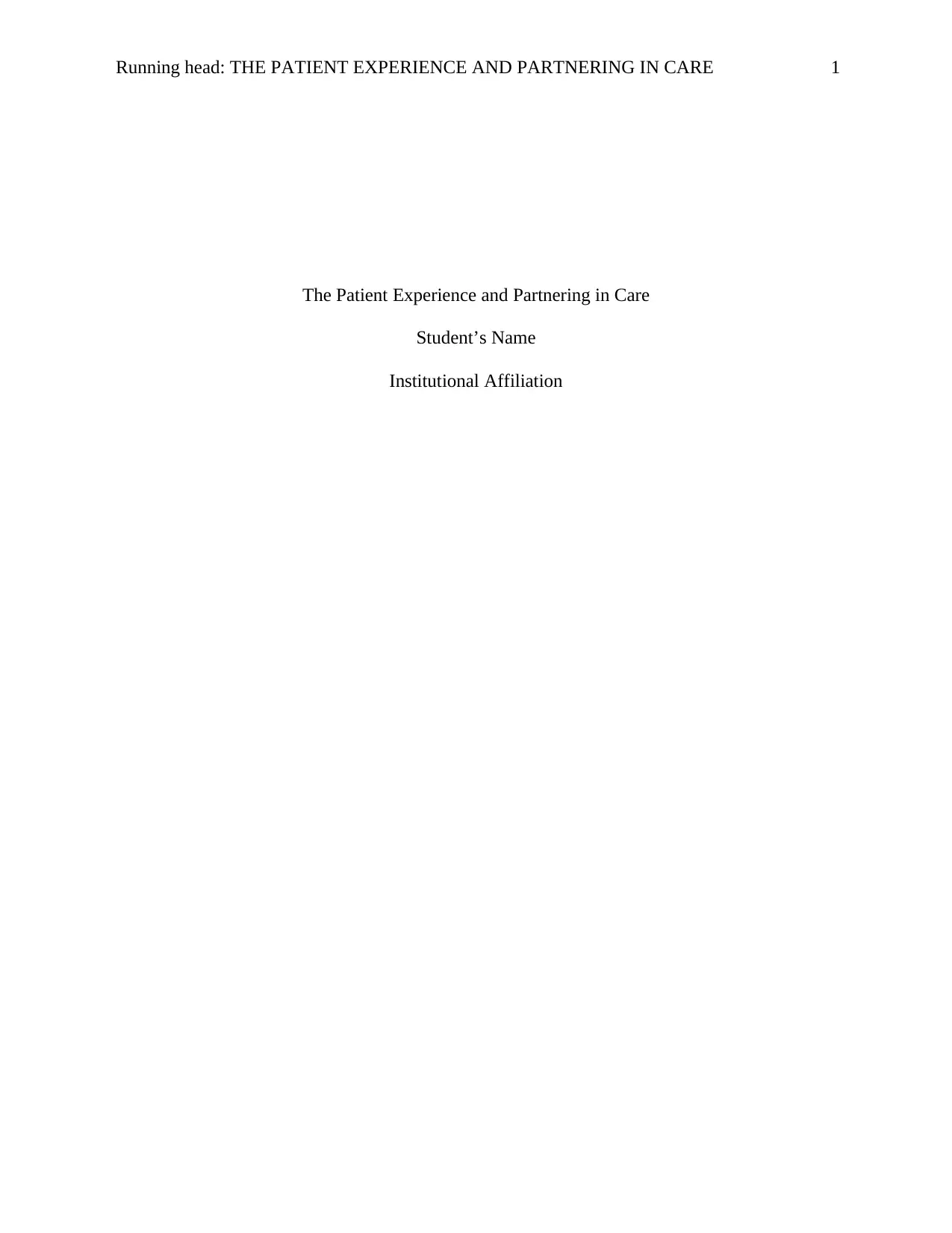
Running head: THE PATIENT EXPERIENCE AND PARTNERING IN CARE 1
The Patient Experience and Partnering in Care
Student’s Name
Institutional Affiliation
The Patient Experience and Partnering in Care
Student’s Name
Institutional Affiliation
Secure Best Marks with AI Grader
Need help grading? Try our AI Grader for instant feedback on your assignments.

THE PATIENT EXPERIENCE AND PARTNERING IN CARE 2
Introduction
Falls lead to injuries in patients and caregivers should suggest effective preventive
measures to curb the effects of the accidents (Bennett et al., 2014). The case scenario presents a
75-years-old who has experienced falls twice, leaving him with severe injuries. e-health records
are essential as they improve the quality of healthcare for falls patients . This essay will describe
feelings and thoughts due to the scenario. Additionally, the write-up will also explore the values
and beliefs towards falls and prevention measures. The paper will then analyze the initial stages
of Gibb's reflection cycle and draw a conclusion based on the patient's experience with falls.
Description: The patient has had two falls. The first experience left him with injuries on
his nose, chin, right shoulder, and left elbow. The client declined to go to the hospital due to his
undesirable experience of waiting for eleven hours for care towards kidney stones. The
caregivers later gave him Codeine to relieve his pain. He could not drive, so the wife had to drive
him to see his GP. His doctor runs an x-ray and instructed him to take it to the surgeon who
indicated that the fall caused a muscle tear on his shoulders. The patient later visited a
physiotherapist who taught him how to use his left arm and other walking aids. The second fall
was due to dizziness. The risk factors for the falls include type two diabetes, hypertension,
anemia, and industrial deafness (Mihaljcic, Haines, Ponsford, & Stolwyk, 2015).
Feelings and Thoughts: The patient's experience has made me feel sad about falls and the
public hospitals in the country. I feel sad because the falls have left the patient with numerous
injuries and pain. The undesirable effects of falls led to the tearing of the muscle on his right
arm; hence limiting his activities to one arm (Hoffman, Hays, Shapiro, Wallace, & Ettner, 2017).
Additionally, the patient cannot drive himself and has to ask his wife to take him to the GP. I
Introduction
Falls lead to injuries in patients and caregivers should suggest effective preventive
measures to curb the effects of the accidents (Bennett et al., 2014). The case scenario presents a
75-years-old who has experienced falls twice, leaving him with severe injuries. e-health records
are essential as they improve the quality of healthcare for falls patients . This essay will describe
feelings and thoughts due to the scenario. Additionally, the write-up will also explore the values
and beliefs towards falls and prevention measures. The paper will then analyze the initial stages
of Gibb's reflection cycle and draw a conclusion based on the patient's experience with falls.
Description: The patient has had two falls. The first experience left him with injuries on
his nose, chin, right shoulder, and left elbow. The client declined to go to the hospital due to his
undesirable experience of waiting for eleven hours for care towards kidney stones. The
caregivers later gave him Codeine to relieve his pain. He could not drive, so the wife had to drive
him to see his GP. His doctor runs an x-ray and instructed him to take it to the surgeon who
indicated that the fall caused a muscle tear on his shoulders. The patient later visited a
physiotherapist who taught him how to use his left arm and other walking aids. The second fall
was due to dizziness. The risk factors for the falls include type two diabetes, hypertension,
anemia, and industrial deafness (Mihaljcic, Haines, Ponsford, & Stolwyk, 2015).
Feelings and Thoughts: The patient's experience has made me feel sad about falls and the
public hospitals in the country. I feel sad because the falls have left the patient with numerous
injuries and pain. The undesirable effects of falls led to the tearing of the muscle on his right
arm; hence limiting his activities to one arm (Hoffman, Hays, Shapiro, Wallace, & Ettner, 2017).
Additionally, the patient cannot drive himself and has to ask his wife to take him to the GP. I
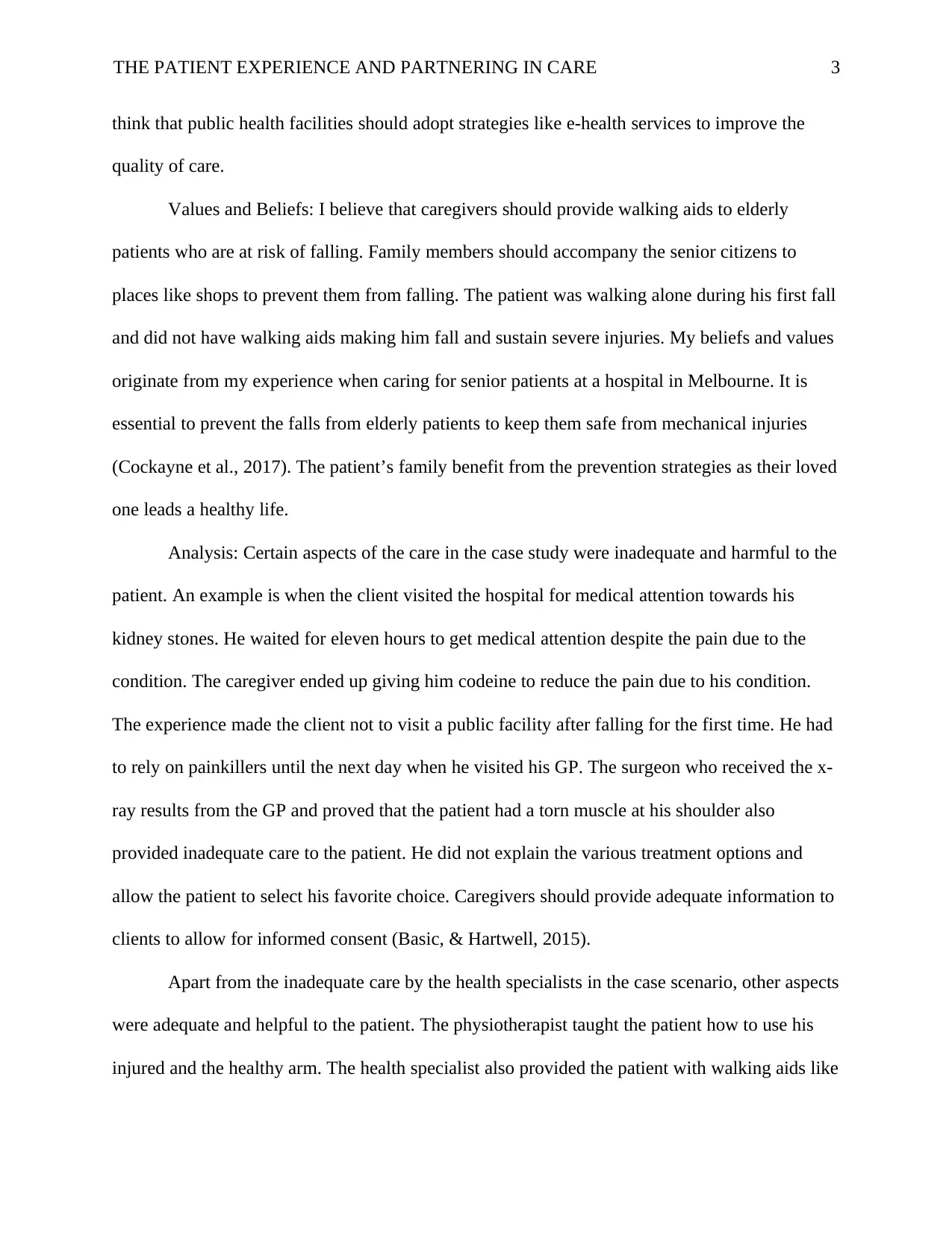
THE PATIENT EXPERIENCE AND PARTNERING IN CARE 3
think that public health facilities should adopt strategies like e-health services to improve the
quality of care.
Values and Beliefs: I believe that caregivers should provide walking aids to elderly
patients who are at risk of falling. Family members should accompany the senior citizens to
places like shops to prevent them from falling. The patient was walking alone during his first fall
and did not have walking aids making him fall and sustain severe injuries. My beliefs and values
originate from my experience when caring for senior patients at a hospital in Melbourne. It is
essential to prevent the falls from elderly patients to keep them safe from mechanical injuries
(Cockayne et al., 2017). The patient’s family benefit from the prevention strategies as their loved
one leads a healthy life.
Analysis: Certain aspects of the care in the case study were inadequate and harmful to the
patient. An example is when the client visited the hospital for medical attention towards his
kidney stones. He waited for eleven hours to get medical attention despite the pain due to the
condition. The caregiver ended up giving him codeine to reduce the pain due to his condition.
The experience made the client not to visit a public facility after falling for the first time. He had
to rely on painkillers until the next day when he visited his GP. The surgeon who received the x-
ray results from the GP and proved that the patient had a torn muscle at his shoulder also
provided inadequate care to the patient. He did not explain the various treatment options and
allow the patient to select his favorite choice. Caregivers should provide adequate information to
clients to allow for informed consent (Basic, & Hartwell, 2015).
Apart from the inadequate care by the health specialists in the case scenario, other aspects
were adequate and helpful to the patient. The physiotherapist taught the patient how to use his
injured and the healthy arm. The health specialist also provided the patient with walking aids like
think that public health facilities should adopt strategies like e-health services to improve the
quality of care.
Values and Beliefs: I believe that caregivers should provide walking aids to elderly
patients who are at risk of falling. Family members should accompany the senior citizens to
places like shops to prevent them from falling. The patient was walking alone during his first fall
and did not have walking aids making him fall and sustain severe injuries. My beliefs and values
originate from my experience when caring for senior patients at a hospital in Melbourne. It is
essential to prevent the falls from elderly patients to keep them safe from mechanical injuries
(Cockayne et al., 2017). The patient’s family benefit from the prevention strategies as their loved
one leads a healthy life.
Analysis: Certain aspects of the care in the case study were inadequate and harmful to the
patient. An example is when the client visited the hospital for medical attention towards his
kidney stones. He waited for eleven hours to get medical attention despite the pain due to the
condition. The caregiver ended up giving him codeine to reduce the pain due to his condition.
The experience made the client not to visit a public facility after falling for the first time. He had
to rely on painkillers until the next day when he visited his GP. The surgeon who received the x-
ray results from the GP and proved that the patient had a torn muscle at his shoulder also
provided inadequate care to the patient. He did not explain the various treatment options and
allow the patient to select his favorite choice. Caregivers should provide adequate information to
clients to allow for informed consent (Basic, & Hartwell, 2015).
Apart from the inadequate care by the health specialists in the case scenario, other aspects
were adequate and helpful to the patient. The physiotherapist taught the patient how to use his
injured and the healthy arm. The health specialist also provided the patient with walking aids like

THE PATIENT EXPERIENCE AND PARTNERING IN CARE 4
sticks. Additionally, the care provided suggested a range of exercises to aid in the recovery
process. The specialist dealing with his anemic condition instructed him to take iron tablets to
balance the body structure and prevent the risk of falling. The gastroenterologist also provides
quality care by telling the patient to intake the pill camera. The specialist prescribed the
telemedicine to monitor the cause of anemia. The diabetes specialists prescribed Metformin
which is an efficient remedy for Type Two diabetes (Healy, Winkler, Brakenridge, Reeves, &
Eakin, 2015). The careers also prescribed Indocin and amlodipine to manage hypertension.
Conclusion Drawn: The public health facilities are performing dismally in caring for
patients. The 75-years-old client in the case study had to wait for eleven hours for care towards
kidney stones. The experience of the client indicates that a fall causes severe injuries to the
victims. The patient injures his muscles, face, and chin among other body parts. The elderly
individuals are at high risk of falling in comparison to different age groups. The risk factors of
falls include anemia, industrial deafness, and hypertension. Anemia limits the ability of blood to
circulate oxygen into the body systems; therefore, an individual feels dizzy and can fall easily.
Industrial deafness prevents an individual from perceiving imposing objects; hence such an
individual is at high risk of falling. Hypertension drugs like Indocin and amlodipine cause
dizziness to the patients (Park, Satoh, Miki, Urushihara, & Sawada, 2015). Therefore, falls
victims should seek alternative remedies for hypertension other than the two medications.
Falls not only affect the patient but also the family of the victim. The wife of the patient
in the case study abandons her chores and drives him to the GP for care. The patient admits that
the whole exercise is stressful for his wife. The victims should embrace the existing prevention
mechanisms for the complication. Caregivers should provide glasses to patients to aid their
sights. The patient should use the hearing aids since he has industrial deafness. Additionally, the
sticks. Additionally, the care provided suggested a range of exercises to aid in the recovery
process. The specialist dealing with his anemic condition instructed him to take iron tablets to
balance the body structure and prevent the risk of falling. The gastroenterologist also provides
quality care by telling the patient to intake the pill camera. The specialist prescribed the
telemedicine to monitor the cause of anemia. The diabetes specialists prescribed Metformin
which is an efficient remedy for Type Two diabetes (Healy, Winkler, Brakenridge, Reeves, &
Eakin, 2015). The careers also prescribed Indocin and amlodipine to manage hypertension.
Conclusion Drawn: The public health facilities are performing dismally in caring for
patients. The 75-years-old client in the case study had to wait for eleven hours for care towards
kidney stones. The experience of the client indicates that a fall causes severe injuries to the
victims. The patient injures his muscles, face, and chin among other body parts. The elderly
individuals are at high risk of falling in comparison to different age groups. The risk factors of
falls include anemia, industrial deafness, and hypertension. Anemia limits the ability of blood to
circulate oxygen into the body systems; therefore, an individual feels dizzy and can fall easily.
Industrial deafness prevents an individual from perceiving imposing objects; hence such an
individual is at high risk of falling. Hypertension drugs like Indocin and amlodipine cause
dizziness to the patients (Park, Satoh, Miki, Urushihara, & Sawada, 2015). Therefore, falls
victims should seek alternative remedies for hypertension other than the two medications.
Falls not only affect the patient but also the family of the victim. The wife of the patient
in the case study abandons her chores and drives him to the GP for care. The patient admits that
the whole exercise is stressful for his wife. The victims should embrace the existing prevention
mechanisms for the complication. Caregivers should provide glasses to patients to aid their
sights. The patient should use the hearing aids since he has industrial deafness. Additionally, the
Secure Best Marks with AI Grader
Need help grading? Try our AI Grader for instant feedback on your assignments.
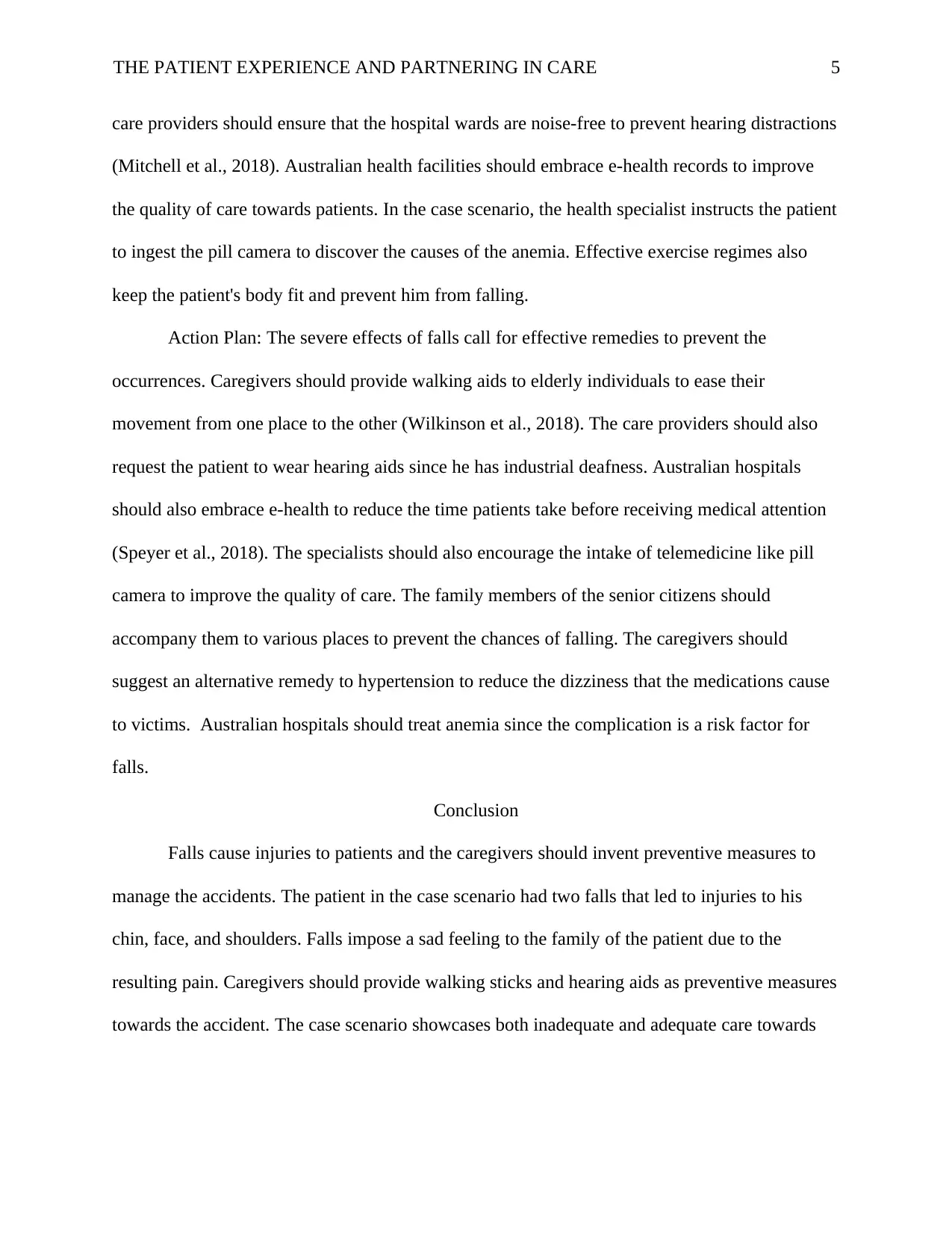
THE PATIENT EXPERIENCE AND PARTNERING IN CARE 5
care providers should ensure that the hospital wards are noise-free to prevent hearing distractions
(Mitchell et al., 2018). Australian health facilities should embrace e-health records to improve
the quality of care towards patients. In the case scenario, the health specialist instructs the patient
to ingest the pill camera to discover the causes of the anemia. Effective exercise regimes also
keep the patient's body fit and prevent him from falling.
Action Plan: The severe effects of falls call for effective remedies to prevent the
occurrences. Caregivers should provide walking aids to elderly individuals to ease their
movement from one place to the other (Wilkinson et al., 2018). The care providers should also
request the patient to wear hearing aids since he has industrial deafness. Australian hospitals
should also embrace e-health to reduce the time patients take before receiving medical attention
(Speyer et al., 2018). The specialists should also encourage the intake of telemedicine like pill
camera to improve the quality of care. The family members of the senior citizens should
accompany them to various places to prevent the chances of falling. The caregivers should
suggest an alternative remedy to hypertension to reduce the dizziness that the medications cause
to victims. Australian hospitals should treat anemia since the complication is a risk factor for
falls.
Conclusion
Falls cause injuries to patients and the caregivers should invent preventive measures to
manage the accidents. The patient in the case scenario had two falls that led to injuries to his
chin, face, and shoulders. Falls impose a sad feeling to the family of the patient due to the
resulting pain. Caregivers should provide walking sticks and hearing aids as preventive measures
towards the accident. The case scenario showcases both inadequate and adequate care towards
care providers should ensure that the hospital wards are noise-free to prevent hearing distractions
(Mitchell et al., 2018). Australian health facilities should embrace e-health records to improve
the quality of care towards patients. In the case scenario, the health specialist instructs the patient
to ingest the pill camera to discover the causes of the anemia. Effective exercise regimes also
keep the patient's body fit and prevent him from falling.
Action Plan: The severe effects of falls call for effective remedies to prevent the
occurrences. Caregivers should provide walking aids to elderly individuals to ease their
movement from one place to the other (Wilkinson et al., 2018). The care providers should also
request the patient to wear hearing aids since he has industrial deafness. Australian hospitals
should also embrace e-health to reduce the time patients take before receiving medical attention
(Speyer et al., 2018). The specialists should also encourage the intake of telemedicine like pill
camera to improve the quality of care. The family members of the senior citizens should
accompany them to various places to prevent the chances of falling. The caregivers should
suggest an alternative remedy to hypertension to reduce the dizziness that the medications cause
to victims. Australian hospitals should treat anemia since the complication is a risk factor for
falls.
Conclusion
Falls cause injuries to patients and the caregivers should invent preventive measures to
manage the accidents. The patient in the case scenario had two falls that led to injuries to his
chin, face, and shoulders. Falls impose a sad feeling to the family of the patient due to the
resulting pain. Caregivers should provide walking sticks and hearing aids as preventive measures
towards the accident. The case scenario showcases both inadequate and adequate care towards
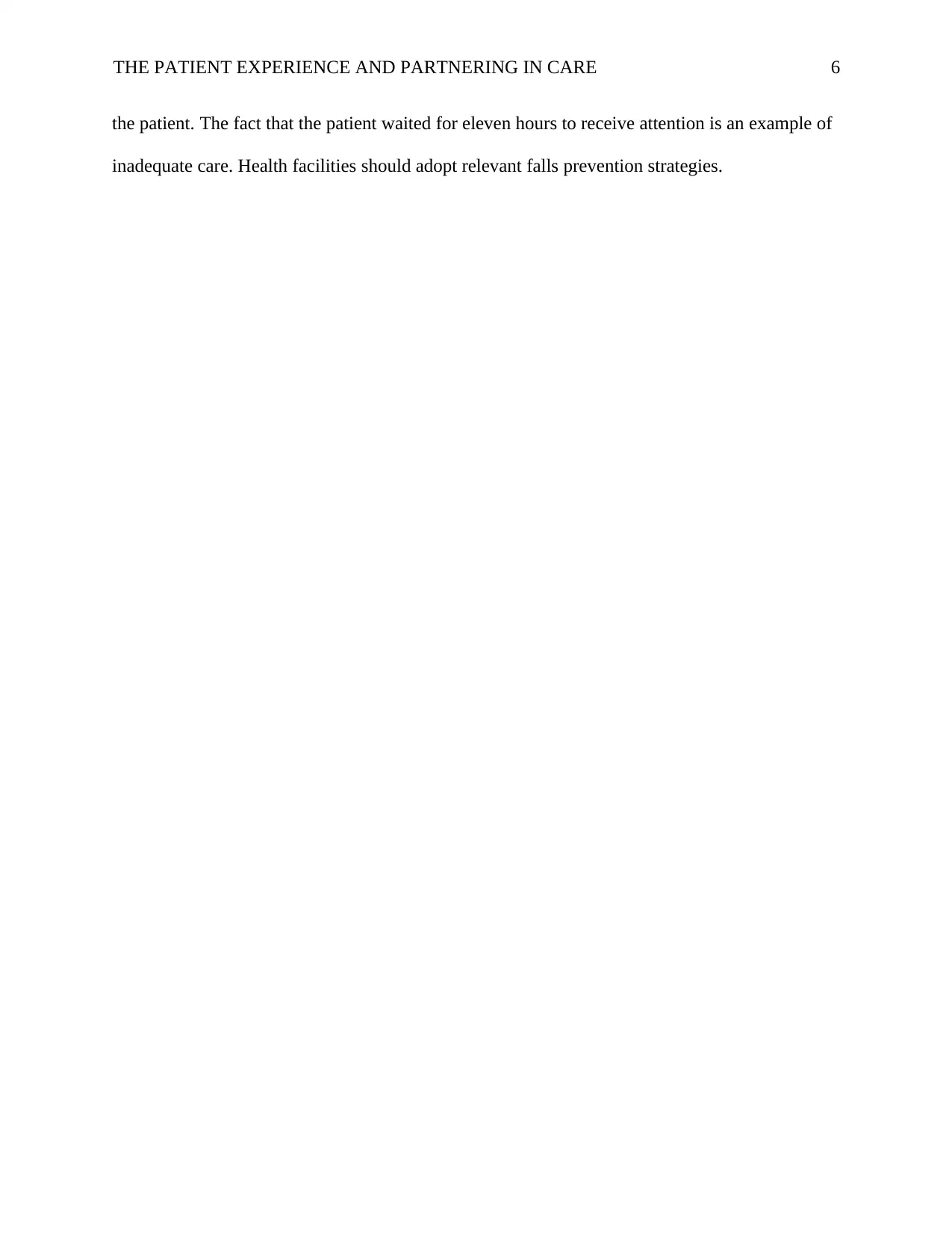
THE PATIENT EXPERIENCE AND PARTNERING IN CARE 6
the patient. The fact that the patient waited for eleven hours to receive attention is an example of
inadequate care. Health facilities should adopt relevant falls prevention strategies.
the patient. The fact that the patient waited for eleven hours to receive attention is an example of
inadequate care. Health facilities should adopt relevant falls prevention strategies.
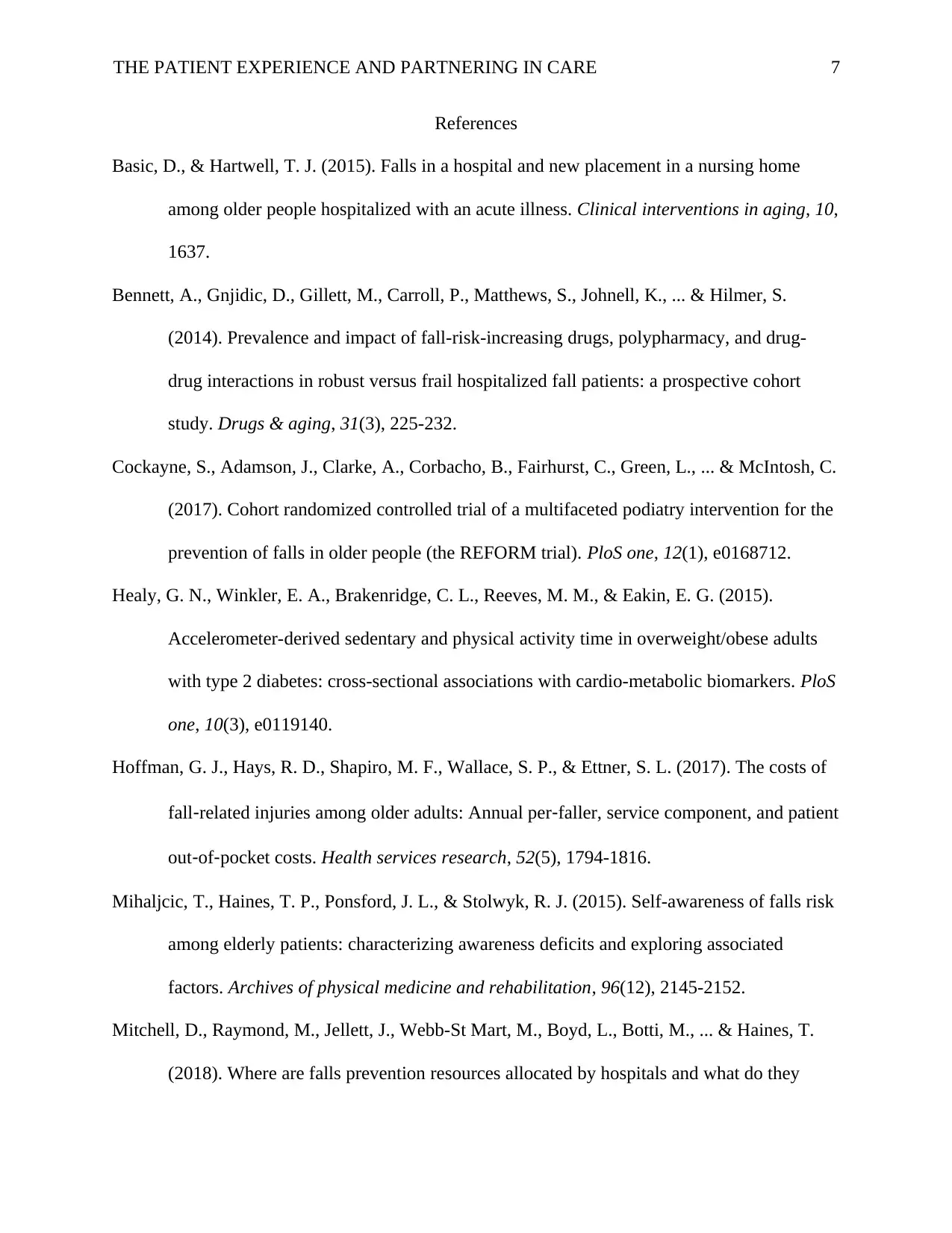
THE PATIENT EXPERIENCE AND PARTNERING IN CARE 7
References
Basic, D., & Hartwell, T. J. (2015). Falls in a hospital and new placement in a nursing home
among older people hospitalized with an acute illness. Clinical interventions in aging, 10,
1637.
Bennett, A., Gnjidic, D., Gillett, M., Carroll, P., Matthews, S., Johnell, K., ... & Hilmer, S.
(2014). Prevalence and impact of fall-risk-increasing drugs, polypharmacy, and drug-
drug interactions in robust versus frail hospitalized fall patients: a prospective cohort
study. Drugs & aging, 31(3), 225-232.
Cockayne, S., Adamson, J., Clarke, A., Corbacho, B., Fairhurst, C., Green, L., ... & McIntosh, C.
(2017). Cohort randomized controlled trial of a multifaceted podiatry intervention for the
prevention of falls in older people (the REFORM trial). PloS one, 12(1), e0168712.
Healy, G. N., Winkler, E. A., Brakenridge, C. L., Reeves, M. M., & Eakin, E. G. (2015).
Accelerometer-derived sedentary and physical activity time in overweight/obese adults
with type 2 diabetes: cross-sectional associations with cardio-metabolic biomarkers. PloS
one, 10(3), e0119140.
Hoffman, G. J., Hays, R. D., Shapiro, M. F., Wallace, S. P., & Ettner, S. L. (2017). The costs of
fall‐related injuries among older adults: Annual per‐faller, service component, and patient
out‐of‐pocket costs. Health services research, 52(5), 1794-1816.
Mihaljcic, T., Haines, T. P., Ponsford, J. L., & Stolwyk, R. J. (2015). Self-awareness of falls risk
among elderly patients: characterizing awareness deficits and exploring associated
factors. Archives of physical medicine and rehabilitation, 96(12), 2145-2152.
Mitchell, D., Raymond, M., Jellett, J., Webb-St Mart, M., Boyd, L., Botti, M., ... & Haines, T.
(2018). Where are falls prevention resources allocated by hospitals and what do they
References
Basic, D., & Hartwell, T. J. (2015). Falls in a hospital and new placement in a nursing home
among older people hospitalized with an acute illness. Clinical interventions in aging, 10,
1637.
Bennett, A., Gnjidic, D., Gillett, M., Carroll, P., Matthews, S., Johnell, K., ... & Hilmer, S.
(2014). Prevalence and impact of fall-risk-increasing drugs, polypharmacy, and drug-
drug interactions in robust versus frail hospitalized fall patients: a prospective cohort
study. Drugs & aging, 31(3), 225-232.
Cockayne, S., Adamson, J., Clarke, A., Corbacho, B., Fairhurst, C., Green, L., ... & McIntosh, C.
(2017). Cohort randomized controlled trial of a multifaceted podiatry intervention for the
prevention of falls in older people (the REFORM trial). PloS one, 12(1), e0168712.
Healy, G. N., Winkler, E. A., Brakenridge, C. L., Reeves, M. M., & Eakin, E. G. (2015).
Accelerometer-derived sedentary and physical activity time in overweight/obese adults
with type 2 diabetes: cross-sectional associations with cardio-metabolic biomarkers. PloS
one, 10(3), e0119140.
Hoffman, G. J., Hays, R. D., Shapiro, M. F., Wallace, S. P., & Ettner, S. L. (2017). The costs of
fall‐related injuries among older adults: Annual per‐faller, service component, and patient
out‐of‐pocket costs. Health services research, 52(5), 1794-1816.
Mihaljcic, T., Haines, T. P., Ponsford, J. L., & Stolwyk, R. J. (2015). Self-awareness of falls risk
among elderly patients: characterizing awareness deficits and exploring associated
factors. Archives of physical medicine and rehabilitation, 96(12), 2145-2152.
Mitchell, D., Raymond, M., Jellett, J., Webb-St Mart, M., Boyd, L., Botti, M., ... & Haines, T.
(2018). Where are falls prevention resources allocated by hospitals and what do they
Paraphrase This Document
Need a fresh take? Get an instant paraphrase of this document with our AI Paraphraser
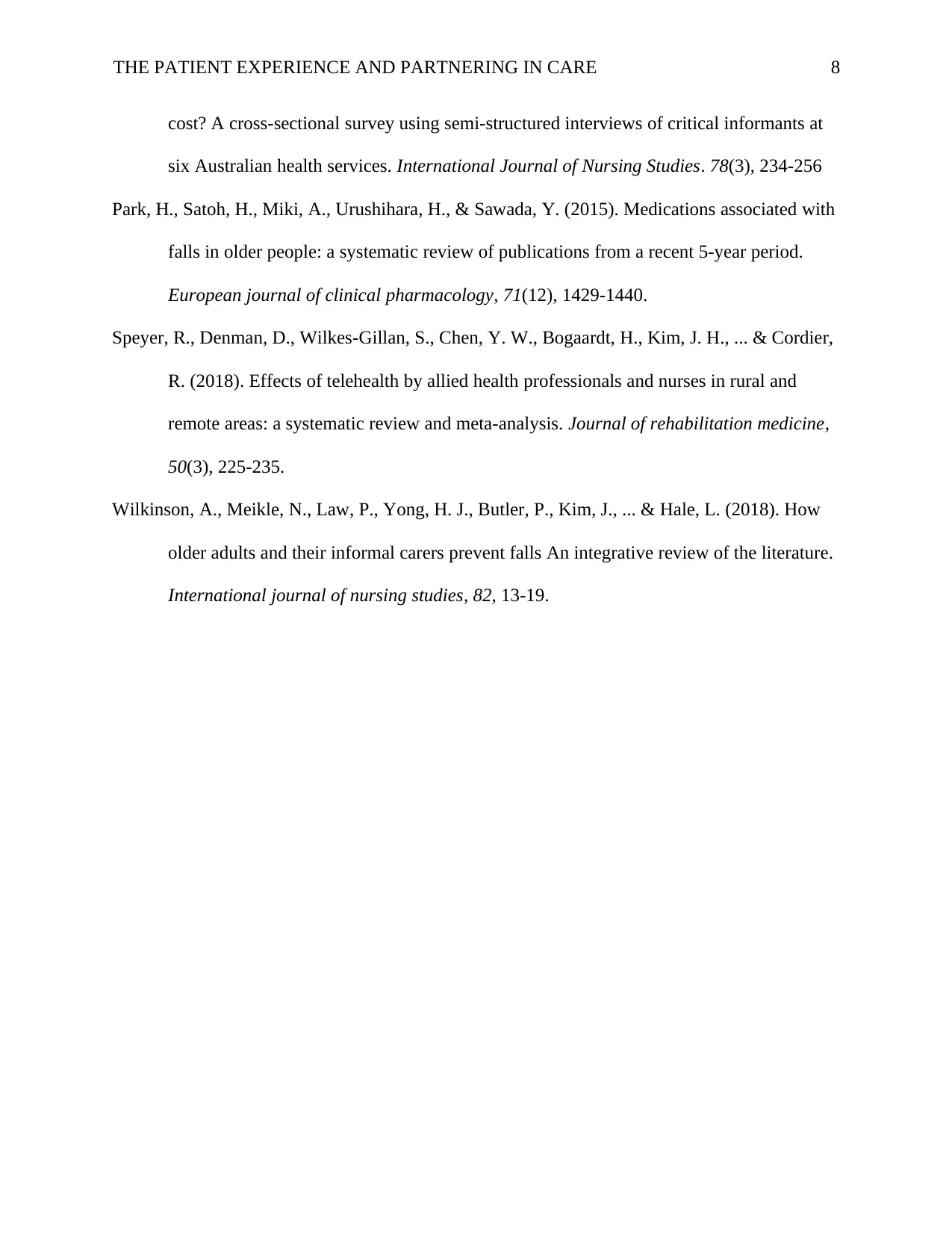
THE PATIENT EXPERIENCE AND PARTNERING IN CARE 8
cost? A cross-sectional survey using semi-structured interviews of critical informants at
six Australian health services. International Journal of Nursing Studies. 78(3), 234-256
Park, H., Satoh, H., Miki, A., Urushihara, H., & Sawada, Y. (2015). Medications associated with
falls in older people: a systematic review of publications from a recent 5-year period.
European journal of clinical pharmacology, 71(12), 1429-1440.
Speyer, R., Denman, D., Wilkes-Gillan, S., Chen, Y. W., Bogaardt, H., Kim, J. H., ... & Cordier,
R. (2018). Effects of telehealth by allied health professionals and nurses in rural and
remote areas: a systematic review and meta-analysis. Journal of rehabilitation medicine,
50(3), 225-235.
Wilkinson, A., Meikle, N., Law, P., Yong, H. J., Butler, P., Kim, J., ... & Hale, L. (2018). How
older adults and their informal carers prevent falls An integrative review of the literature.
International journal of nursing studies, 82, 13-19.
cost? A cross-sectional survey using semi-structured interviews of critical informants at
six Australian health services. International Journal of Nursing Studies. 78(3), 234-256
Park, H., Satoh, H., Miki, A., Urushihara, H., & Sawada, Y. (2015). Medications associated with
falls in older people: a systematic review of publications from a recent 5-year period.
European journal of clinical pharmacology, 71(12), 1429-1440.
Speyer, R., Denman, D., Wilkes-Gillan, S., Chen, Y. W., Bogaardt, H., Kim, J. H., ... & Cordier,
R. (2018). Effects of telehealth by allied health professionals and nurses in rural and
remote areas: a systematic review and meta-analysis. Journal of rehabilitation medicine,
50(3), 225-235.
Wilkinson, A., Meikle, N., Law, P., Yong, H. J., Butler, P., Kim, J., ... & Hale, L. (2018). How
older adults and their informal carers prevent falls An integrative review of the literature.
International journal of nursing studies, 82, 13-19.
1 out of 8
Related Documents
Your All-in-One AI-Powered Toolkit for Academic Success.
+13062052269
info@desklib.com
Available 24*7 on WhatsApp / Email
![[object Object]](/_next/static/media/star-bottom.7253800d.svg)
Unlock your academic potential
© 2024 | Zucol Services PVT LTD | All rights reserved.




